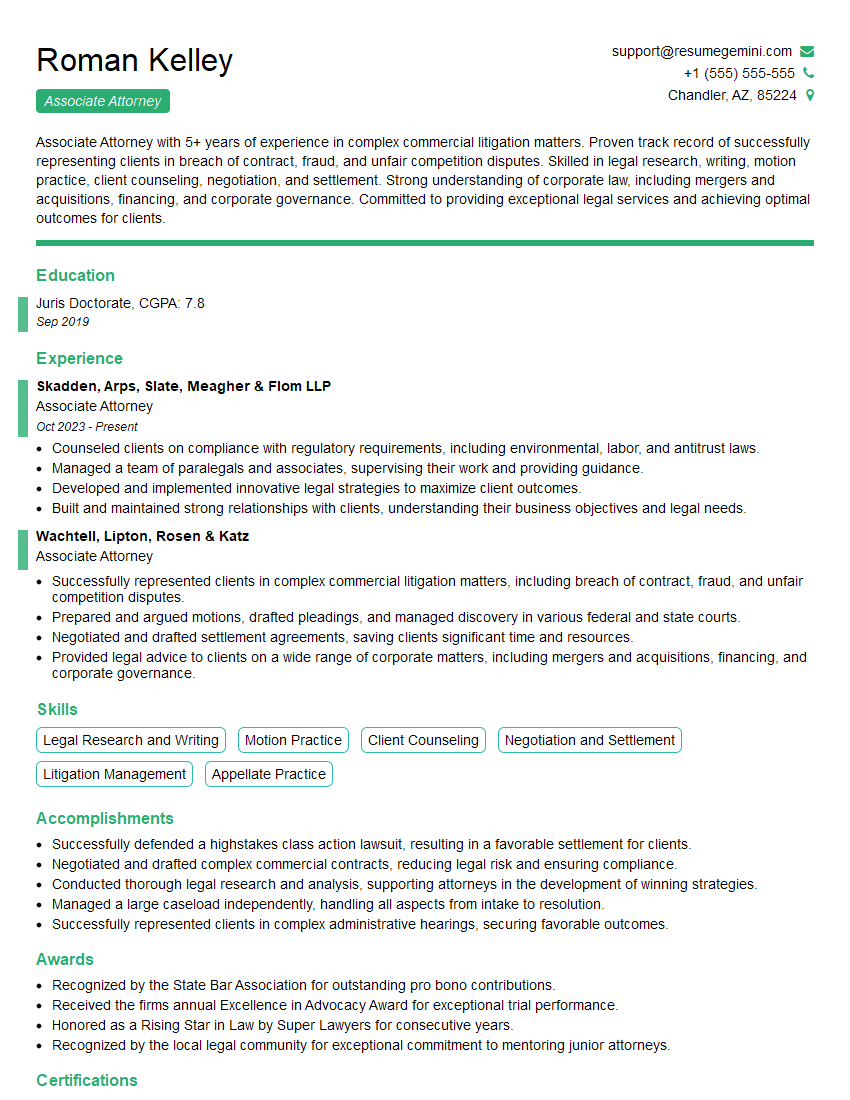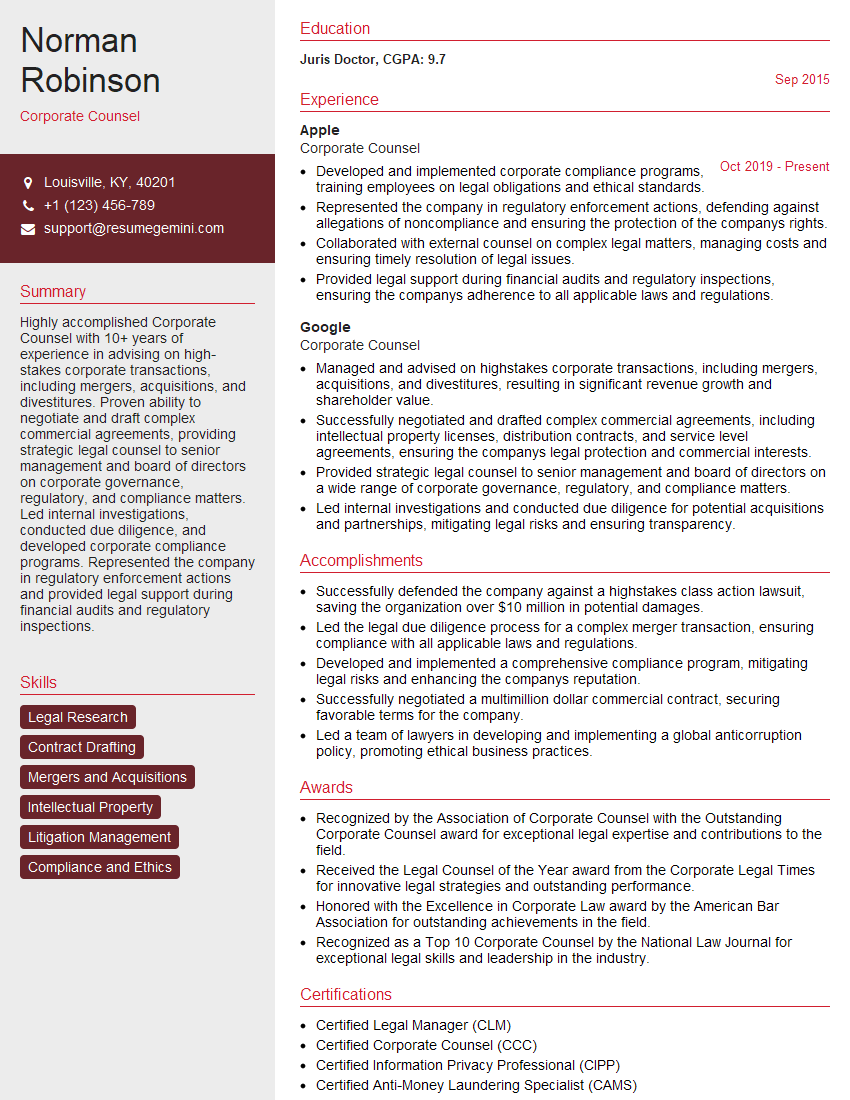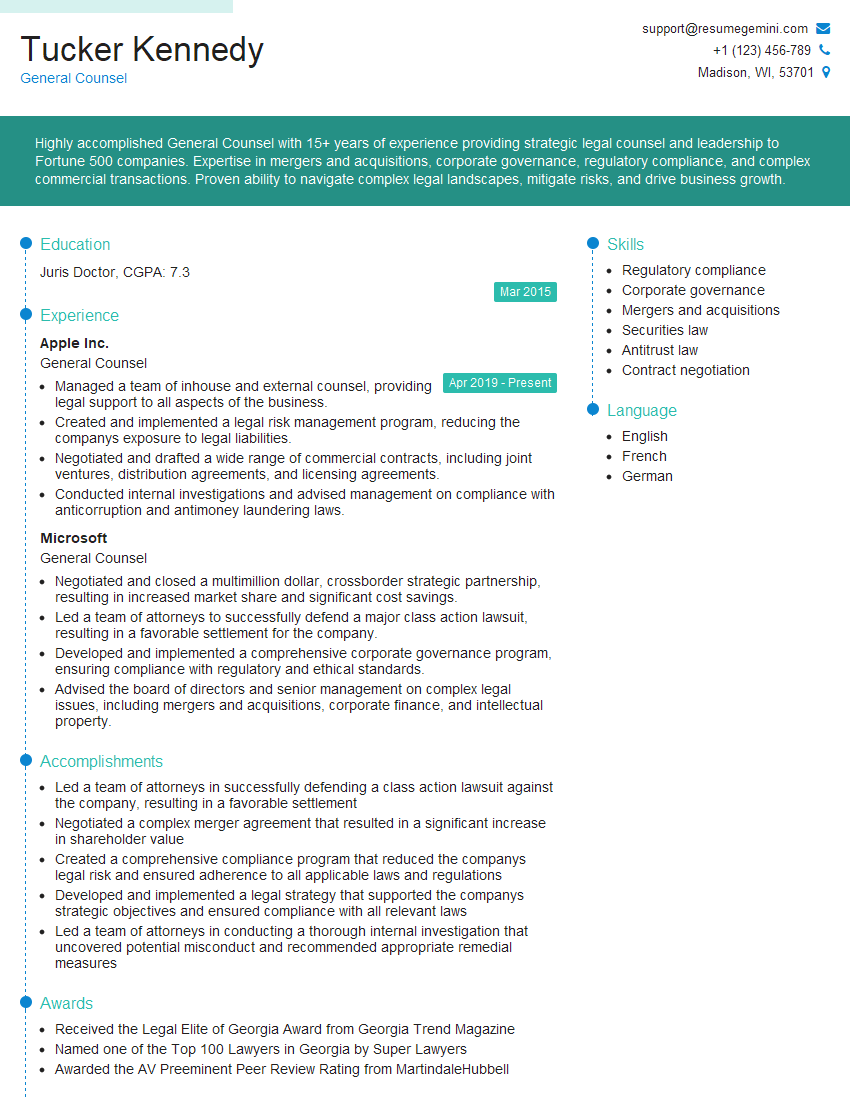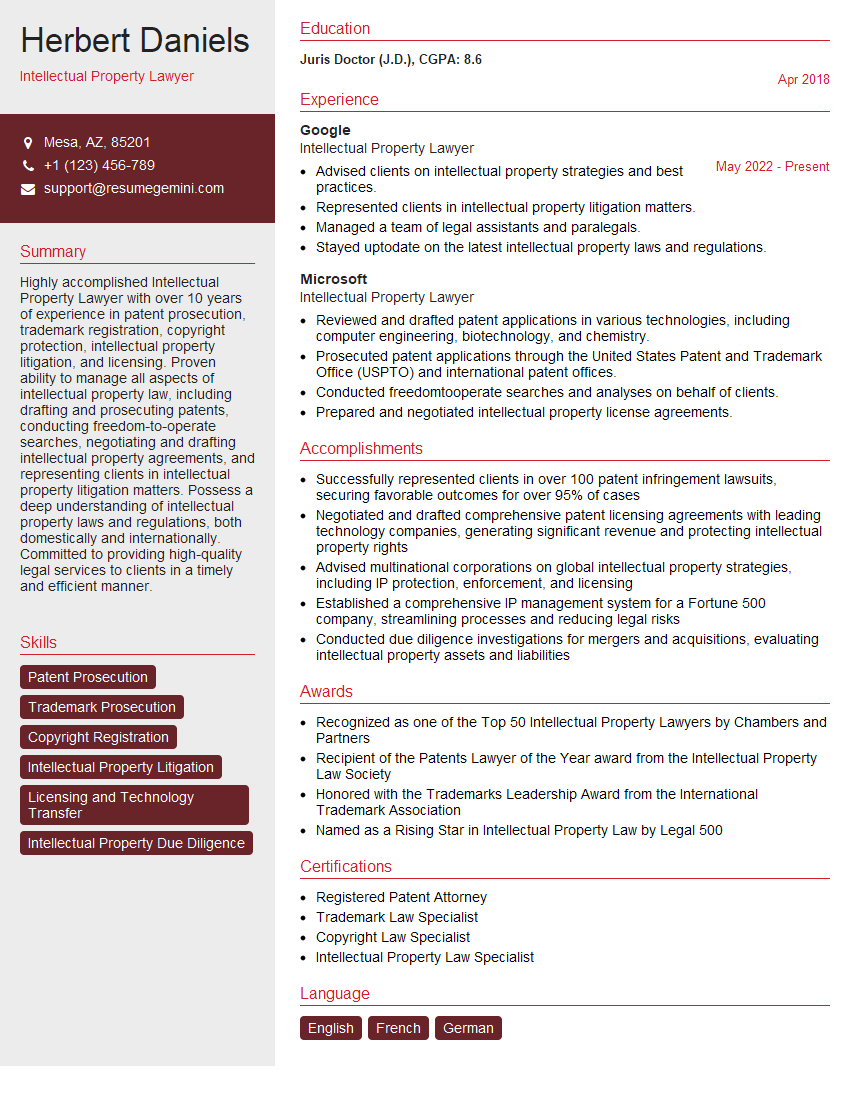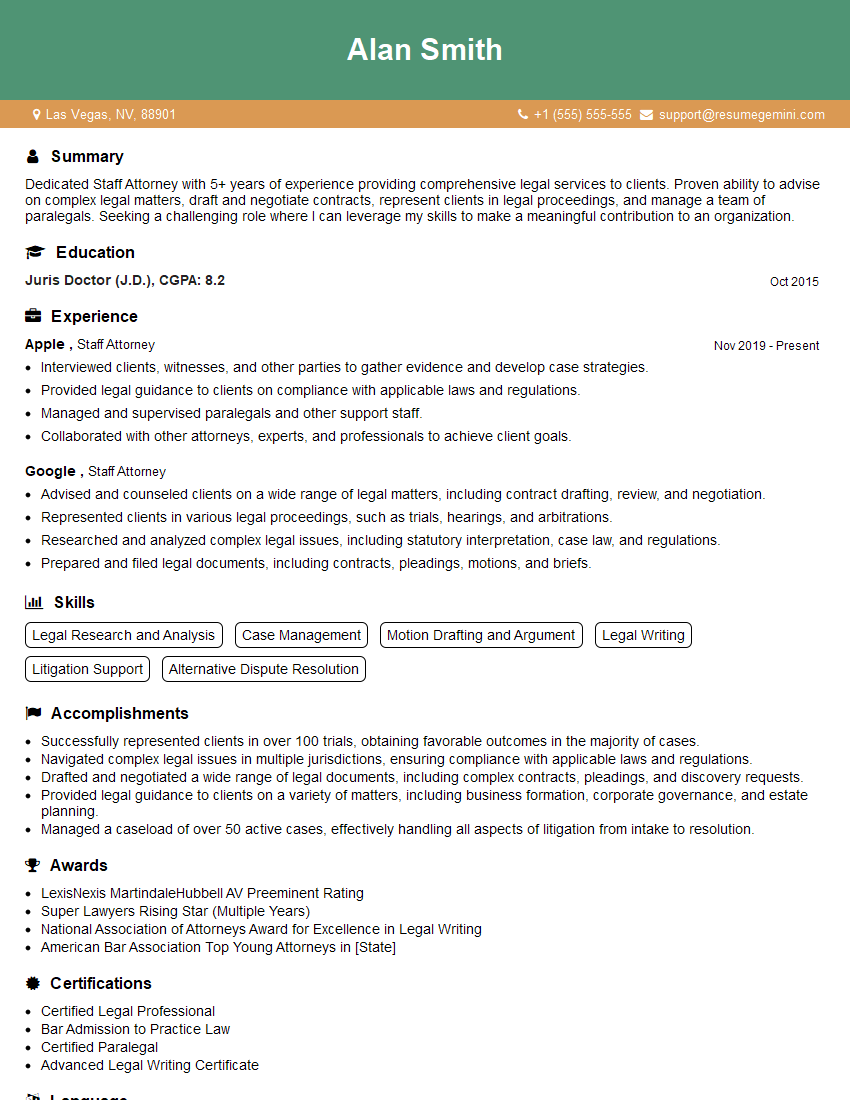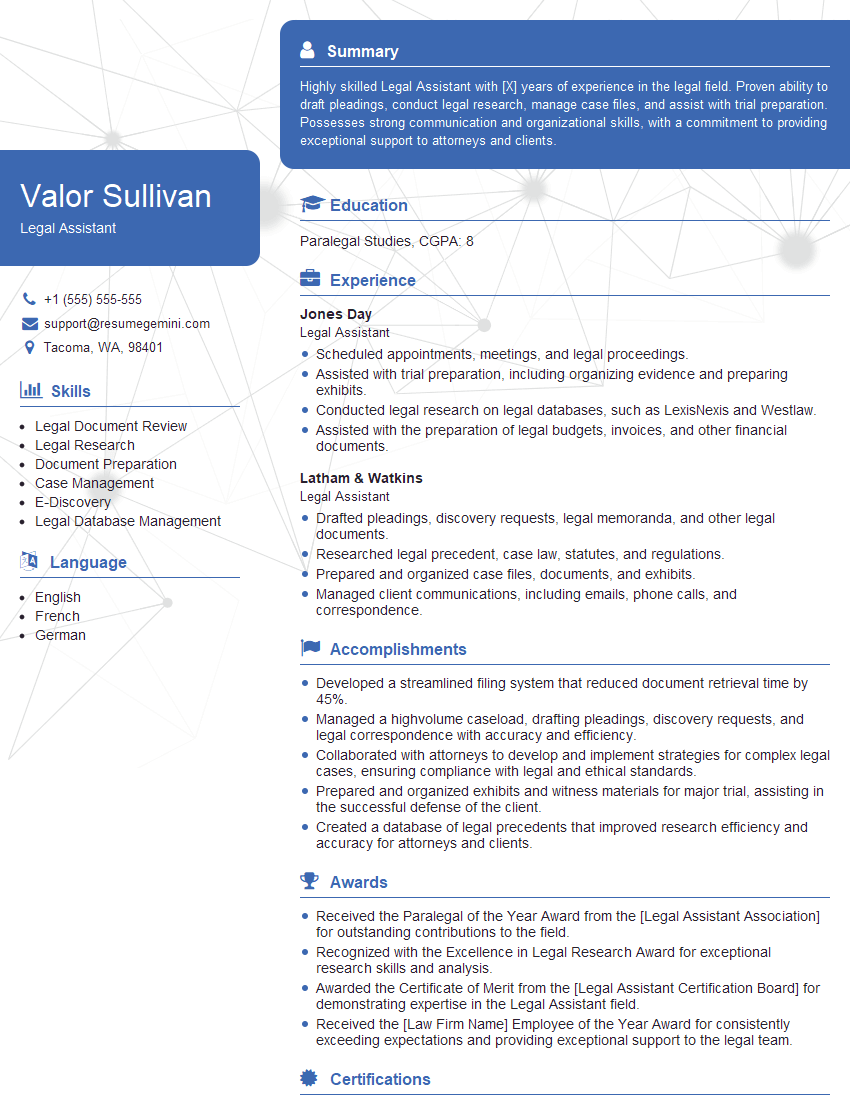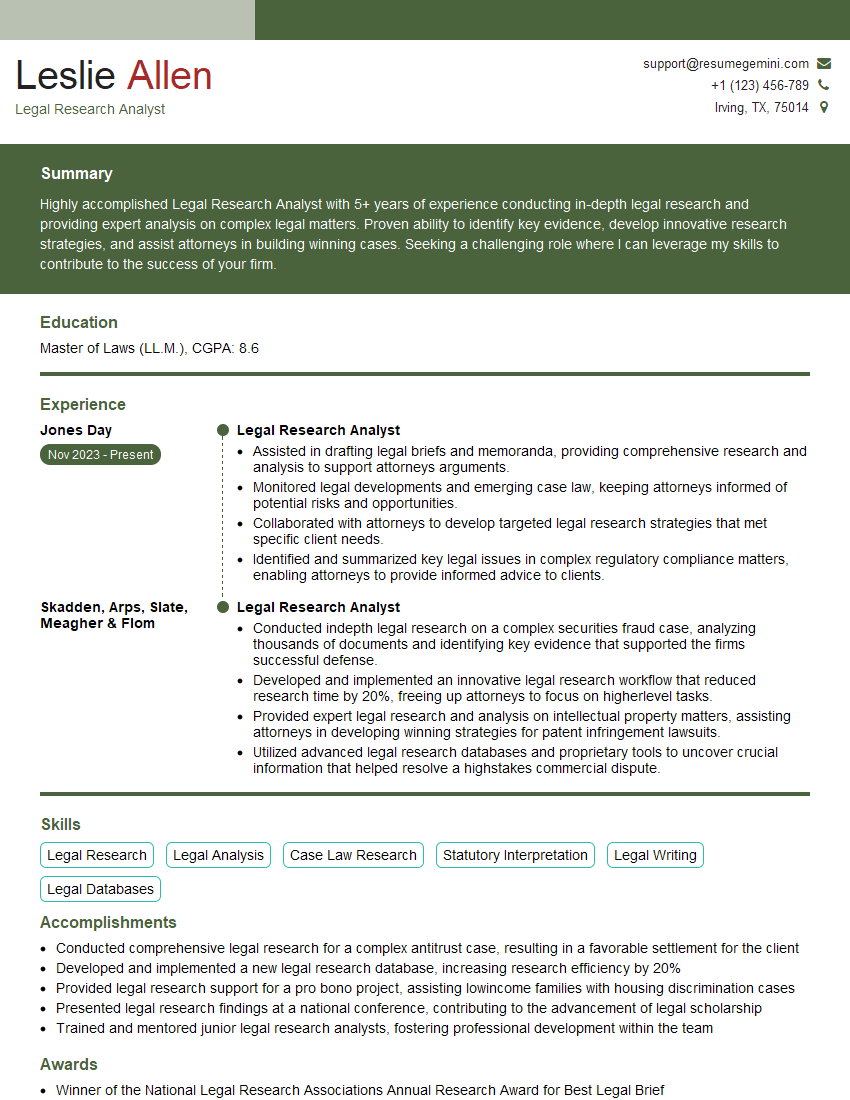Unlock your full potential by mastering the most common Legal Knowledge and Ethics interview questions. This blog offers a deep dive into the critical topics, ensuring you’re not only prepared to answer but to excel. With these insights, you’ll approach your interview with clarity and confidence.
Questions Asked in Legal Knowledge and Ethics Interview
Q 1. Define ‘legal privilege’ and explain its limitations.
Legal privilege is a rule of evidence that protects confidential communications between certain parties, such as a lawyer and their client. This protection prevents the disclosure of these communications in legal proceedings, even if the information is relevant to the case. The core principle is to encourage open and honest communication between parties who need to trust each other to effectively pursue legal strategies.
However, legal privilege isn’t absolute and has several limitations. For example, the communication must be for the purpose of seeking or providing legal advice. If the communication is primarily for business purposes, or if it involves planning or committing a crime, privilege may not apply. Additionally, the privilege belongs to the client, not the lawyer. The client can waive the privilege and allow the communication to be disclosed. Finally, specific exceptions exist, like when there’s a threat of imminent harm to another person. Imagine a client confiding in their lawyer about their intent to harm someone – that information wouldn’t be protected by privilege. The scope of privilege also varies based on jurisdiction and the type of privilege (e.g., attorney-client, doctor-patient, spousal).
Q 2. Explain the concept of ‘conflict of interest’ in a legal context.
A conflict of interest arises when a lawyer or other professional has competing loyalties or duties that could compromise their ability to act in the best interests of their client or employer. This could involve situations where their personal interests, the interests of another client, or other professional obligations clash with their primary duty. For example, a lawyer cannot represent two clients with opposing interests in the same case without their informed consent. This can also occur within a company; a manager might face a conflict if they’re asked to make a decision that benefits their friend and potentially harms the company.
Think of it like this: Imagine a chef preparing two dishes – one for a guest with a nut allergy and one for a guest who loves nuts. A conflict of interest arises if the chef uses the same utensils, contaminating both dishes. Similarly, in legal practice, a conflict can lead to compromised representation and potentially unethical outcomes. Proper disclosure, and sometimes even recusal from a case or matter, are necessary to avoid conflicts of interest.
Q 3. Describe the role of a compliance officer in a corporate setting.
A compliance officer is a crucial role in many organizations, responsible for developing, implementing, and monitoring a company’s compliance program. They ensure the company adheres to all applicable laws, regulations, and internal policies. This involves identifying potential risks, developing strategies to mitigate those risks, and training employees on relevant compliance matters. They also act as a point of contact for employees to report potential violations, conducting internal investigations and reporting findings to management and relevant authorities when necessary.
In essence, they are the guardians of ethical conduct within the organization. Imagine them as the ‘ethical compass’ of the company, making sure everyone is navigating in accordance with the rules and regulations. They often work closely with legal counsel and senior management to ensure a robust and effective compliance framework.
Q 4. What are the key components of a strong corporate ethics program?
A strong corporate ethics program requires several key components working together. First, it needs a clear and concise code of conduct that articulates the company’s values and ethical standards, defining what constitutes acceptable and unacceptable behavior. Second, it must include comprehensive ethics training for all employees, at all levels, to ensure understanding and engagement with the program. Third, effective communication channels are crucial – employees need a safe and accessible way to report ethical concerns without fear of retaliation.
Beyond this, a strong program includes mechanisms for identifying and addressing potential conflicts of interest, a system for conducting thorough investigations of reported violations, and meaningful consequences for misconduct. Finally, regular reviews and updates are vital to ensure the program remains relevant and effective. Think of it like building a house – you need a strong foundation (code of conduct), sturdy walls (training and communication), a reliable roof (investigation and consequences), and regular maintenance (reviews).
Q 5. How would you handle a situation where you witness unethical behavior in the workplace?
Witnessing unethical behavior requires a careful and considered response. The first step is to document the incident thoroughly, including dates, times, locations, and involved parties. Then, I would consider the severity of the misconduct. If it poses immediate harm, I would report it immediately to the appropriate authorities (such as compliance or legal). For less serious but still concerning issues, I might first try to address it directly with the individual involved, depending on my relationship with them and the workplace culture.
If internal channels fail or the behavior continues, I would escalate the matter up the chain of command, reporting to my supervisor or the compliance officer. Throughout this process, it’s important to maintain objectivity, accurately document everything, and protect myself from potential retaliation. Reporting unethical behavior can be challenging, but it’s a crucial aspect of maintaining workplace integrity. Remember to prioritize your safety and well-being while acting ethically.
Q 6. Explain the difference between civil and criminal law.
Civil law and criminal law are distinct branches of law with different goals and procedures. Civil law deals with disputes between individuals or organizations, focusing on resolving conflicts and providing remedies for harm. The outcome is usually financial compensation or equitable relief (like an injunction). Examples include breach of contract, negligence, and property disputes. The burden of proof is lower in civil cases (preponderance of the evidence). Think of a neighbor dispute over a damaged fence – this is a civil matter.
Criminal law, on the other hand, deals with actions that are considered offenses against the state. It aims to punish individuals who violate criminal statutes, protecting society and deterring future crimes. Criminal cases involve prosecution by the government and potential penalties like fines, imprisonment, or even death. The burden of proof is much higher (beyond a reasonable doubt). Think of theft or assault – these are criminal offenses.
Q 7. What is the significance of the Sarbanes-Oxley Act (SOX)?
The Sarbanes-Oxley Act (SOX) of 2002 is a landmark piece of legislation enacted in response to major corporate accounting scandals. It significantly impacts corporate governance and financial reporting, aiming to restore investor confidence and protect shareholders. Key provisions include enhanced corporate responsibility for financial reporting, stricter regulations for auditors, and increased penalties for non-compliance. It mandates greater transparency in financial disclosures, strengthens internal controls, and establishes an independent board oversight of financial reporting practices.
SOX has had a profound effect on corporate practices worldwide, setting a higher standard for accountability and ethical conduct within publicly traded companies. Compliance with SOX is crucial for avoiding severe penalties and maintaining a strong reputation.
Q 8. Describe your understanding of the Foreign Corrupt Practices Act (FCPA).
The Foreign Corrupt Practices Act (FCPA) is a United States federal law that prohibits bribery of foreign officials. It’s essentially a powerful tool to combat corruption on a global scale. The act targets companies and individuals, holding them accountable for offering, promising, or authorizing payments to foreign officials to obtain or retain business. It also addresses accounting practices, demanding accurate and transparent record-keeping to prevent the concealment of bribes.
The FCPA has two main components: the anti-bribery provisions and the accounting provisions. The anti-bribery provisions prohibit the offering, promising, or giving anything of value to a foreign official to influence an official act or to obtain or retain business. The accounting provisions require companies to maintain accurate books and records and implement internal accounting controls.
Example: Imagine a US company negotiating a contract in a foreign country. If they offer a significant ‘gift’ to a government official to secure the deal, that’s a clear violation of the FCPA, even if it’s not explicitly labeled as a bribe. The act extends to intermediaries, making companies accountable for the actions of their agents, even if the company itself didn’t directly authorize the bribe.
Understanding the FCPA is crucial for multinational corporations. Failure to comply can lead to severe penalties, including hefty fines and even criminal prosecution.
Q 9. What is due diligence, and why is it important in legal practice?
Due diligence is the process of investigating and verifying information to ensure accuracy and mitigate risk. Think of it as thorough fact-checking, but on a much larger scale, often before making a significant decision. In legal practice, it’s absolutely essential.
Due diligence involves a wide range of activities, depending on the context. It might include reviewing contracts, conducting background checks, scrutinizing financial records, and assessing environmental impacts. The specific steps taken will vary according to the legal issue involved, but the fundamental principle remains the same: minimizing risk by verifying information and uncovering potential problems early.
Why is it important? Due diligence protects clients, protects lawyers from potential liability, and improves the quality of legal advice. A lawyer who hasn’t performed due diligence might unknowingly represent a client with a conflict of interest, advise on a transaction with hidden liabilities, or make critical errors in their legal work.
Example: Before representing a client in a merger and acquisition, a lawyer would conduct thorough due diligence on the target company, including examining its financials, contracts, and compliance history to identify any potential legal risks or problems that might impact the deal. Without such thorough investigation, the lawyer could provide inaccurate advice or expose themselves to liability.
Q 10. Explain the concept of ‘informed consent’ in a legal context.
Informed consent, in a legal context, means that a person voluntarily agrees to a course of action, such as undergoing medical treatment or entering into a contract, after being fully informed of all relevant information. This means the person understands the potential risks, benefits, and alternatives.
Key Elements of Informed Consent:
- Disclosure: The professional must provide all material information necessary for a rational person to make a decision. This includes the nature of the procedure, the risks and benefits, alternative treatments, and the risks of refusing treatment.
- Comprehension: The person receiving the information must understand it. This might require the professional to use clear language, avoid jargon, and ensure the person can ask questions and receive clear answers.
- Voluntariness: The person must make the decision freely, without coercion, manipulation, or undue influence.
- Capacity: The person must be legally competent to make the decision. Individuals lacking mental capacity, like minors or those with severe cognitive impairments, may require consent from a legal guardian.
Example: Before a patient undergoes surgery, the surgeon must explain the procedure, potential complications (e.g., infection, bleeding), and alternative treatments. The patient must then agree to the surgery, demonstrating both understanding and willingness to proceed. Without informed consent, a doctor could face malpractice claims.
Q 11. What are the ethical considerations surrounding the use of artificial intelligence in legal practice?
The use of artificial intelligence (AI) in legal practice presents both exciting opportunities and significant ethical considerations. AI tools can automate tasks, improve efficiency, and enhance legal research, but their application demands careful ethical scrutiny.
Key Ethical Considerations:
- Bias and Discrimination: AI algorithms are trained on data, and if that data reflects existing societal biases, the AI system may perpetuate and even amplify those biases in its outputs, leading to unfair or discriminatory outcomes.
- Transparency and Explainability: Many AI systems, particularly deep learning models, are ‘black boxes.’ It can be difficult to understand how they reach their conclusions, making it hard to identify and correct errors or biases. This lack of transparency can erode trust and accountability.
- Data Privacy and Security: AI systems often rely on vast amounts of data, raising concerns about the privacy and security of sensitive client information. Robust data protection measures are essential.
- Job Displacement: Automation through AI could lead to job displacement for legal professionals, raising ethical concerns about the impact on the workforce and the need for reskilling and upskilling initiatives.
- Responsibility and Liability: Determining liability when an AI system makes a mistake or provides inaccurate legal advice is a complex issue. Clear guidelines are needed to assign responsibility and ensure accountability.
Addressing these concerns requires a multi-faceted approach: developing ethical guidelines for AI in law, promoting transparency and explainability in AI systems, ensuring robust data privacy and security, and investing in education and training to prepare the legal profession for the changing landscape.
Q 12. How do you stay updated on changes in relevant laws and regulations?
Staying updated on legal changes is critical. I employ a multi-pronged approach:
- Professional Organizations: I actively participate in relevant professional organizations such as bar associations and specialized legal groups. These organizations often provide continuing legal education (CLE) programs, newsletters, and journals that cover the latest legal developments.
- Legal Databases and News Sources: I regularly consult reputable legal databases like Westlaw or LexisNexis, as well as trusted legal news sources, to track changes in legislation, case law, and regulations.
- Continuing Legal Education (CLE): I prioritize attending CLE programs, webinars, and conferences to stay abreast of changes in the law and best practices.
- Networking: I maintain a strong network of colleagues and experts in my field, enabling informal knowledge sharing and discussion of current legal issues.
- Subscription Services: I subscribe to relevant legal newsletters and alerts to receive timely updates on important legal developments.
This proactive approach allows me to ensure my legal advice is accurate, current, and ethically sound.
Q 13. Describe a time you had to make a difficult ethical decision.
In a previous role, I represented a client facing a complex environmental lawsuit. The client, a small manufacturing company, had unknowingly violated environmental regulations, and the potential penalties were substantial. The client’s owner, a close friend, confided in me that falsifying records would significantly reduce the penalties, even though this was unethical and illegal. He argued that the company’s closure would result in job losses and severe financial hardship for his family and employees.
This presented a severe ethical dilemma. My duty was to uphold the law and ensure the client provided accurate information. However, I also understood the significant consequences of the company’s potential closure. I decided to advise the client of the legal ramifications of falsifying records, and I explored every possible avenue for mitigating the penalties while complying with the law. This included thoroughly investigating the violation, negotiating with the regulatory agency, and seeking a settlement that balanced legal compliance with the economic realities faced by the company and its employees. Ultimately, a settlement was reached that minimized the penalties while protecting the company and its workers. This experience emphasized the importance of prioritizing ethical conduct even in challenging circumstances, while also recognizing the broader human impact of legal decisions.
Q 14. What are some common legal pitfalls companies face regarding data privacy?
Companies face numerous legal pitfalls regarding data privacy, particularly with increasingly stringent regulations like GDPR (General Data Protection Regulation) and CCPA (California Consumer Privacy Act). Some common pitfalls include:
- Insufficient Consent: Failing to obtain valid, informed consent from individuals before collecting and processing their personal data is a major violation. Consent must be freely given, specific, informed, and unambiguous.
- Data Breaches: Not implementing adequate security measures to protect personal data can lead to costly data breaches, resulting in regulatory fines, legal liabilities, and reputational damage.
- Lack of Transparency: Not being transparent with individuals about how their data is collected, used, and shared can violate privacy laws.
- Inadequate Data Retention Policies: Failing to establish and follow clear data retention policies – keeping data only as long as necessary – can lead to non-compliance.
- Cross-border Data Transfers: Transferring personal data across international borders without complying with relevant data transfer agreements can result in legal problems.
- Failure to Comply with Specific Regulations: Ignoring or failing to adapt to specific data privacy regulations such as GDPR, CCPA, or other regional laws can lead to significant fines and legal action.
Companies must develop comprehensive data privacy programs, implement robust security measures, and ensure that their practices comply with all applicable laws and regulations to mitigate these risks.
Q 15. Explain the importance of legal documentation and record-keeping.
Legal documentation and record-keeping are paramount for several reasons. Think of it as building a solid foundation for any legal endeavor. It provides irrefutable evidence of agreements, transactions, and compliance efforts. Without meticulous records, navigating disputes becomes exponentially harder, and the risk of legal vulnerabilities increases significantly.
- Evidence in Litigation: Detailed records serve as crucial evidence in court cases, arbitration, or mediation. They can substantiate claims, defend against accusations, and establish timelines of events.
- Compliance and Auditing: Many regulations mandate specific record-keeping practices. Maintaining accurate records ensures compliance with relevant laws and allows for smooth audits by regulatory bodies.
- Business Continuity: Comprehensive records facilitate business continuity in case of unforeseen events like mergers, acquisitions, or staff turnover. They provide a clear picture of past transactions and ongoing commitments.
- Risk Management: Thorough record-keeping helps identify potential legal risks early on, enabling proactive mitigation strategies. This minimizes the chances of costly legal battles and reputational damage.
For example, imagine a construction company without detailed contracts and payment records. If a dispute arises over payment, proving the agreed-upon terms and payment history would become incredibly challenging.
Career Expert Tips:
- Ace those interviews! Prepare effectively by reviewing the Top 50 Most Common Interview Questions on ResumeGemini.
- Navigate your job search with confidence! Explore a wide range of Career Tips on ResumeGemini. Learn about common challenges and recommendations to overcome them.
- Craft the perfect resume! Master the Art of Resume Writing with ResumeGemini’s guide. Showcase your unique qualifications and achievements effectively.
- Don’t miss out on holiday savings! Build your dream resume with ResumeGemini’s ATS optimized templates.
Q 16. How do you navigate conflicts between legal requirements and business objectives?
Navigating conflicts between legal requirements and business objectives requires a careful balancing act. It’s not about choosing one over the other, but finding creative and compliant solutions that align both. This often involves a collaborative approach among legal, business, and compliance teams.
- Identify the Conflict: Clearly define the specific legal requirement and the business objective that are in conflict. What exactly is the clash?
- Assess the Risks: Evaluate the potential legal and business consequences of non-compliance versus adapting the business objective. Which option carries greater risk?
- Explore Solutions: Brainstorm alternative approaches to achieve the business objective while remaining legally compliant. This might involve revising strategies, seeking legal exemptions, or exploring alternative technologies.
- Document the Decision: Clearly document the chosen solution, including the rationale behind it. This demonstrates due diligence and transparency.
- Monitor and Review: Regularly monitor the effectiveness of the chosen solution and be prepared to adjust if needed. The legal landscape and business objectives can change.
For instance, a company aiming for rapid expansion might face conflicts with environmental regulations. The solution might involve investing in environmentally friendly technologies or finding alternative expansion strategies that minimize environmental impact.
Q 17. What are the key elements of a legally sound contract?
A legally sound contract is a cornerstone of any business transaction. It’s a legally binding agreement that protects the interests of all parties involved. Several key elements are essential:
- Offer and Acceptance: A clear offer by one party and its unconditional acceptance by the other.
- Consideration: Something of value exchanged by each party. This could be money, goods, services, or a promise to do or not do something.
- Capacity: All parties must have the legal capacity to enter into a contract; they must be of legal age and mentally competent.
- Legality: The contract’s purpose must be legal. Illegal activities cannot be the subject of a valid contract.
- Mutual Assent (Meeting of the Minds): Both parties must understand and agree to the terms of the contract.
- Specificity: The terms of the contract must be clear, concise, and unambiguous. Vague language can lead to disputes.
- Signed by Parties: To be fully enforceable, the contract usually requires signatures from all parties involved.
For example, a contract lacking consideration—where one party receives nothing in return for their commitment—would likely be deemed unenforceable.
Q 18. How familiar are you with different types of legal research methods?
My legal research methods are comprehensive and adaptable to the specifics of each case. I’m proficient in various techniques:
- Statutory Research: I’m adept at using online legal databases (like Westlaw or LexisNexis) and government websites to find relevant statutes, codes, and regulations.
- Case Law Research: I’m skilled in locating and analyzing judicial decisions using case reporters and online legal databases. This involves understanding case precedents and their application.
- Secondary Source Research: I effectively utilize legal treatises, law reviews, and scholarly articles to gain a broader understanding of legal principles and arguments.
- Jurisprudential Research: I can delve into the philosophical and theoretical underpinnings of legal issues to provide a comprehensive analysis.
- Document Review: I’m proficient in reviewing contracts, pleadings, and other legal documents to identify key facts and legal issues.
I’m also experienced in using Boolean search operators and other advanced search techniques to refine my searches and identify relevant information efficiently.
Q 19. Explain your understanding of intellectual property rights.
Intellectual property (IP) rights protect creations of the mind, such as inventions, literary and artistic works, designs, and symbols, names, and images used in commerce.
- Patents: Grant exclusive rights to inventors for their inventions.
- Copyrights: Protect original literary, dramatic, musical, and artistic works.
- Trademarks: Protect brand names, logos, and other distinctive identifiers used in commerce.
- Trade Secrets: Protect confidential information that provides a competitive advantage.
Understanding IP rights is crucial for businesses to protect their innovations and brand identity. Infringement can lead to significant legal repercussions, including hefty fines and injunctions. For instance, a company using another company’s trademark without permission could face serious legal action.
Q 20. What are the ethical implications of using client confidential information?
Using client confidential information unethically has severe ethical and legal implications. It’s a breach of trust that can severely damage the attorney-client relationship and even lead to disciplinary action or legal liability.
- Breach of Confidentiality: Disclosing client information without consent is a serious ethical violation. Attorneys have a professional duty of confidentiality, which is often enshrined in rules of professional conduct.
- Legal Liability: Depending on the nature of the disclosure and the jurisdiction, unauthorized disclosure can lead to civil lawsuits for damages or even criminal charges.
- Reputational Damage: Ethical breaches can severely tarnish an attorney’s reputation and erode client trust.
- Disciplinary Action: Professional disciplinary bodies can impose sanctions, such as suspension or disbarment, for violating ethical rules.
Maintaining client confidentiality is not merely a matter of professional ethics; it’s a cornerstone of the legal profession’s integrity and vital for building strong client relationships based on trust.
Q 21. How do you ensure compliance with anti-bribery and anti-corruption laws?
Compliance with anti-bribery and anti-corruption laws, such as the Foreign Corrupt Practices Act (FCPA) in the US, is crucial for businesses operating internationally or domestically. It requires a multi-faceted approach.
- Establish a Robust Compliance Program: This involves creating clear policies, procedures, and controls to prevent bribery and corruption. Training employees on these policies is essential.
- Conduct Due Diligence: Thoroughly vetting business partners and third-party agents to identify potential risks of corruption.
- Risk Assessment: Regularly assess risks of bribery and corruption, identifying areas needing enhanced controls.
- Internal Controls: Implementing strong internal financial controls and accounting practices to prevent the misuse of funds.
- Whistleblowing Mechanisms: Establishing secure and confidential channels for employees to report potential violations without fear of retaliation.
- Record Keeping: Maintaining accurate and detailed records of all financial transactions and interactions with government officials.
- Training and Education: Providing regular ethics training to employees to reinforce the importance of compliance.
Failing to comply can result in substantial fines, reputational damage, and even criminal prosecution for both the company and individuals involved.
Q 22. Describe your experience with legal risk assessment and mitigation.
Legal risk assessment and mitigation is a proactive process of identifying, analyzing, and reducing potential legal problems that could harm an organization. It involves systematically evaluating the organization’s activities, identifying potential legal vulnerabilities, and implementing strategies to minimize the likelihood and impact of legal issues.
In my experience, this involves a multi-step approach. First, I conduct a thorough review of the organization’s operations, contracts, policies, and procedures to pinpoint areas of potential legal risk. This might include reviewing employment contracts for compliance with labor laws, analyzing marketing materials for adherence to advertising regulations, or assessing data security measures to comply with privacy laws like GDPR or CCPA. Second, I analyze the likelihood and potential severity of each identified risk. For instance, a minor breach of contract might have a low likelihood and low severity, while a data breach exposing sensitive customer information presents a high likelihood and high severity risk. Third, I develop and implement mitigation strategies, which might include revising policies, implementing new training programs, purchasing insurance, or consulting with external legal experts. For example, if a risk assessment reveals weaknesses in data security, I would recommend implementing stronger encryption, access controls, and employee training programs to mitigate the risk of a data breach. Finally, I regularly monitor and review the effectiveness of the implemented mitigation strategies, making adjustments as needed. This ensures the organization stays ahead of emerging legal challenges and maintains a strong legal compliance posture.
For example, in a previous role, I identified a significant risk related to non-compliance with environmental regulations in a manufacturing facility. Through a comprehensive assessment, we developed a remediation plan that included upgrading equipment, implementing stricter waste management protocols, and training employees on new environmental regulations. This prevented costly fines and potential legal action.
Q 23. What is your understanding of corporate social responsibility and its legal implications?
Corporate Social Responsibility (CSR) refers to a company’s commitment to operating ethically and sustainably, considering the impact of its actions on its employees, customers, communities, and the environment. It’s more than just philanthropy; it’s integrating social and environmental concerns into a company’s business operations and interactions with stakeholders.
The legal implications of CSR are multifaceted. While there isn’t a single overarching CSR law, many legal obligations directly relate to CSR initiatives. For example, environmental regulations dictate how companies must manage their waste and emissions, consumer protection laws impact how companies interact with their customers, and labor laws govern employee treatment. Failure to comply with these laws, often intertwined with CSR principles, can lead to significant legal repercussions, including fines, lawsuits, and reputational damage. Furthermore, a company’s commitment to ethical practices, transparency, and accountability, key aspects of CSR, can help mitigate legal risks by fostering trust and positive relationships with stakeholders.
Increasingly, stakeholders, including investors and consumers, are demanding greater transparency and accountability from companies regarding their social and environmental impact. This pressure can translate into legal obligations as governments and regulatory bodies respond to public demand for stricter corporate accountability. For instance, the growing focus on climate change has led to stricter environmental regulations and increased litigation against companies perceived as contributing to environmental damage.
Q 24. Explain the concept of ‘whistleblowing’ and its legal protections.
Whistleblowing is the act of reporting illegal, unethical, or improper activities within an organization to an external authority or the public. This often involves reporting wrongdoing that could harm the public, violate the law, or damage the organization’s reputation.
Legal protections for whistleblowers vary significantly depending on the jurisdiction and the specific laws involved. Many countries have implemented laws to protect whistleblowers from retaliation by their employers. These protections often include prohibiting employers from firing, demoting, or otherwise discriminating against employees who report wrongdoing in good faith. For example, the Sarbanes-Oxley Act in the United States provides specific protections for whistleblowers reporting financial fraud. Similarly, the EU’s Whistleblower Protection Directive aims to establish a common framework across member states. However, it is crucial to note that these protections are not absolute, and there are usually specific conditions and procedures that must be followed to qualify for protection. For instance, the report must be made in good faith, and the information reported must be accurate to the best of the whistleblower’s knowledge. Moreover, the legal framework surrounding whistleblowing is constantly evolving, reflecting a growing societal emphasis on corporate transparency and accountability. As such, it is vital to be aware of applicable laws and regulations when considering or responding to a whistleblowing situation.
Q 25. How would you handle a situation where a client instructs you to do something unethical?
If a client instructs me to do something unethical, my response would be guided by my professional ethical obligations and the applicable rules of professional conduct. This is a critical situation that necessitates a clear and decisive response. I would first attempt to understand the client’s reasoning and explore alternative approaches that align with ethical and legal principles.
My steps would be:
- Seek Clarification: I would engage in a calm and professional discussion with the client to fully understand their instructions and the rationale behind them. I’d gently explain why the proposed action is unethical and potentially illegal. I would try to find common ground and explore a more ethical alternative.
- Explain the Ethical and Legal Ramifications: I would clearly outline the potential consequences of undertaking the unethical instruction. This would include potential legal liabilities for both the client and myself, as well as reputational damage.
- Seek Internal Advice: I would consult with my firm’s ethics committee or senior partners to seek guidance and ensure my response aligns with our firm’s policies and ethical standards. This is critical for protecting both myself and the firm from any potential repercussions.
- Refuse the Instruction: If persuasion and internal consultation fail, I would firmly refuse to follow the client’s unethical instructions, explaining that I’m bound by professional ethical obligations to uphold the law and act with integrity. This refusal may necessitate withdrawing from representing the client.
- Consider Reporting: In some cases, the client’s instruction may involve illegal activity, requiring me to consider reporting it to the appropriate authorities, while maintaining client confidentiality to the extent possible within the bounds of the law.
Ultimately, my priority would be to uphold my ethical obligations and ensure compliance with the law. Maintaining professional integrity is paramount, even if it means losing a client.
Q 26. What strategies do you use to identify and manage legal risks within an organization?
Identifying and managing legal risks within an organization requires a proactive and comprehensive approach. I employ several strategies to achieve this.
- Risk Assessment: This involves a systematic review of the organization’s operations, identifying potential legal vulnerabilities across different areas like contracts, employment, intellectual property, data protection, and environmental compliance. This assessment is often facilitated through questionnaires, interviews with key personnel, and document review.
- Policy and Procedure Review: Existing policies and procedures are examined for adequacy and compliance with relevant laws and regulations. Outdated or insufficient policies are revised or replaced.
- Training and Education: Regular training programs for employees on legal compliance issues are crucial. This helps increase awareness of legal risks and fosters a culture of compliance within the organization.
- Monitoring and Reporting: A system for tracking and reporting potential legal issues is essential. This involves regular monitoring of relevant legislation, compliance audits, and internal reporting mechanisms.
- Legal Counsel Consultation: Engaging external legal counsel to provide expert advice on complex legal issues is important. This can significantly reduce the risk of costly litigation or regulatory sanctions.
- Technology and Data Security: Implementing robust technological safeguards to protect sensitive data and ensure compliance with data protection laws is vital in today’s digital environment.
- Insurance: Securing appropriate insurance coverage to mitigate financial losses arising from legal risks is a crucial aspect of a robust risk management plan.
These strategies, used in a coordinated and continuous manner, create a strong legal compliance framework and help proactively identify and manage legal risks within an organization.
Q 27. Describe your experience with legal negotiations and contract drafting.
My experience in legal negotiations and contract drafting spans various sectors, including commercial, corporate, and intellectual property law. I’m proficient in negotiating favorable terms for clients, drafting legally sound and commercially viable contracts, and managing the entire contract lifecycle from negotiation to execution and beyond.
In negotiations, my approach emphasizes clear communication, active listening, and a strategic understanding of my client’s objectives. I’m adept at identifying and addressing potential points of conflict and finding creative solutions that benefit all parties involved. I’m comfortable with both collaborative and more adversarial negotiation styles, adapting my approach to the specific circumstances and the personalities involved.
In contract drafting, I strive for clarity, precision, and completeness. I ensure that all essential terms are clearly defined, potential risks are addressed, and the contract reflects the client’s intentions accurately and comprehensively. I’m familiar with various types of contracts, including NDAs, licensing agreements, service agreements, and sales contracts, and I tailor my drafting style to the specific context. I regularly utilize precedent documents and best practices to ensure efficiency and legal soundness. After drafting, I rigorously review all contracts to ensure accuracy and completeness, avoiding ambiguity and potential legal pitfalls. Furthermore, I am experienced in providing post-contractual support and guidance to clients.
Q 28. How would you handle a situation involving a conflict between two competing legal principles?
Conflicts between competing legal principles are common in law. Resolving these requires a nuanced understanding of the relevant principles, the facts of the specific case, and the applicable legal framework. There’s no single solution, but a structured approach is key.
My approach involves:
- Identifying and Defining the Competing Principles: Clearly articulate the specific legal principles at odds. This might involve statutory provisions, case law precedents, or constitutional rights.
- Analyzing the Facts: Thoroughly examine the specific facts of the situation to determine how each principle applies. The facts are crucial in determining which principle should prevail.
- Considering the Hierarchy of Laws: Determine the relative weight or precedence of each principle. For instance, a constitutional right generally overrides a statutory provision that conflicts with it.
- Applying Relevant Legal Tests: If the principles are not clearly hierarchical, specific legal tests might help determine which principle should be given greater weight. This might involve balancing competing interests, applying proportionality tests, or considering public policy implications.
- Considering Policy Implications: The broader social and public policy implications of applying each principle are considered. This often guides the decision-making process.
- Reviewing Case Law: Examining relevant case law to see how courts have resolved similar conflicts in the past provides valuable guidance.
Ultimately, the resolution often involves a balancing act, carefully weighing the competing interests and principles to reach a just and equitable outcome. In some cases, creative legal solutions might be needed to reconcile the conflicting principles. The decision-making process should be transparent and well-documented, highlighting the reasoning and rationale behind the choice.
Key Topics to Learn for Your Legal Knowledge and Ethics Interview
- Legal Research & Analysis: Mastering effective legal research techniques, including understanding case law, statutes, and regulations, and applying them to analyze complex legal scenarios.
- Ethical Frameworks & Codes of Conduct: Understanding and applying ethical principles, such as confidentiality, duty of loyalty, and conflict of interest, within various legal contexts. Consider the practical application of these principles in different legal settings.
- Professional Responsibility: Exploring the responsibilities of legal professionals, including maintaining client confidentiality, complying with professional rules, and managing conflicts of interest. Think about real-world scenarios where these responsibilities come into play.
- Legal Writing & Communication: Developing clear, concise, and persuasive legal writing skills, including memo writing, brief writing, and client communication. Practice structuring your arguments logically and effectively.
- Specific Areas of Law (Relevant to your application): Depending on the specific role, delve into the relevant areas of law (e.g., contract law, criminal law, intellectual property law). Focus on understanding core principles and their practical implications.
- Problem-solving & Critical Thinking: Develop your ability to analyze legal problems, identify key issues, and formulate effective solutions. Practice approaching legal problems methodically and creatively.
Next Steps: Unlock Your Legal Career Potential
Mastering Legal Knowledge and Ethics is crucial for building a successful and fulfilling career in law. A strong foundation in these areas demonstrates your professionalism, commitment to ethical practice, and ability to navigate complex legal challenges. To significantly boost your job prospects, create a compelling and ATS-friendly resume that highlights your skills and experience effectively. ResumeGemini is a trusted resource to help you craft a professional resume tailored to the legal field. We provide examples of resumes specifically designed for candidates with expertise in Legal Knowledge and Ethics to guide you through the process. Invest in building a standout resume – it’s your first impression on potential employers.
Explore more articles
Users Rating of Our Blogs
Share Your Experience
We value your feedback! Please rate our content and share your thoughts (optional).
What Readers Say About Our Blog
This was kind of a unique content I found around the specialized skills. Very helpful questions and good detailed answers.
Very Helpful blog, thank you Interviewgemini team.







